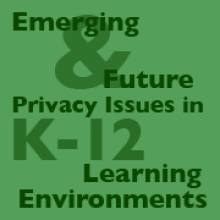Building off several prior working meetings which mapped and considered the implications of the new and rapidly evolving ecosystem of networked technology being used with education (“ed tech”), the Berkman Center for Internet & Society’s Student Privacy Initiative convened a conversation in May 2015 among multiple stakeholders, including, but not limited to, K-12 educators, district administrators, academics, policy makers, and industry representatives. This working meeting was envisioned as one in a series of conversations which deepens our understanding of emerging and future privacy issues in K-12 learning environments, both formal and informal. Future conversations may focus on specific topics within the broader spectrum of issues relating to student privacy; this particular working meeting prioritized practicality over theoretical discussion, emphasizing the evolving experiences of K-12 administrators, educators, and students.
In order to evaluate the challenges and opportunities fostered by the next generation of ed tech, participants were asked to consider the following four layers of the ed tech ecosystem, each of which informs the others in myriad ways: Technological Infrastructure: What kind of technology can be considered “ed tech”? This layer encompasses cloud infrastructure, the Internet of Things, sensor networks, and other new technologies that facilitate connected learning environments (which transcend the traditional classroom set-up, disturb hierarchies, and foster peer-to-peer interactions) and other educational innovations within brick and mortar classrooms, thereby shaping the collection and use of student/educational data. Data: What kinds of data are being collected, and how/by whom are they being used? This layer includes the opportunities afforded by learning analytics (the aggregation of data about learners, offering the potential benefit of individualized learning trajectories and the potential challenge of limiting or discriminatory “tracking”), as well as other uses by educators, administrators, and other stakeholders of individual and cohort-wide student data previously unimaginable in both its breadth and depth. Organizational Structures: Where does learning take place today? This layer maps the institutional forms of current and future educational institutions, from traditional schoolhouses to informal learning environments, which can be situated within the context of schools, cities, libraries, and elsewhere -- and are perhaps best understood as part of the connected learning ecosystem. Norms and values: How do we want ed tech to be used in the classroom, and what are our expectations for/desires of privacy? This layer reflects those principles, policies, pedagogies, and practices that do or should animate the goals, implementation, and stakeholder experiences of twenty-first century digital education in its various iterations.
PDF

